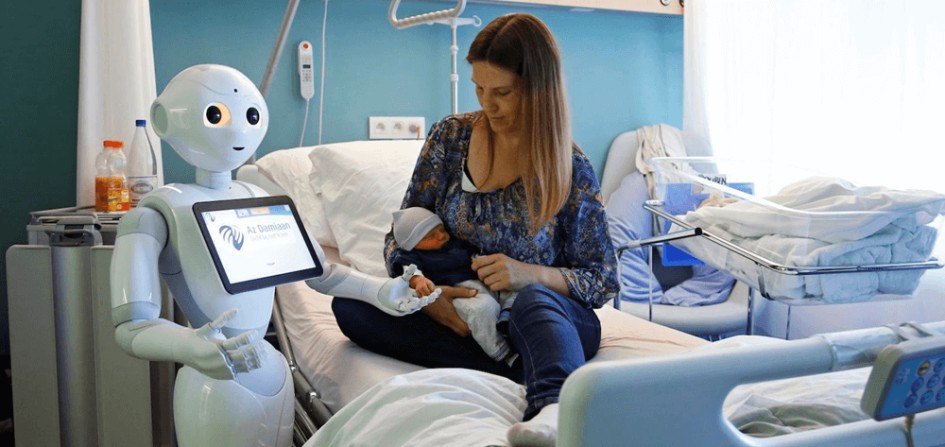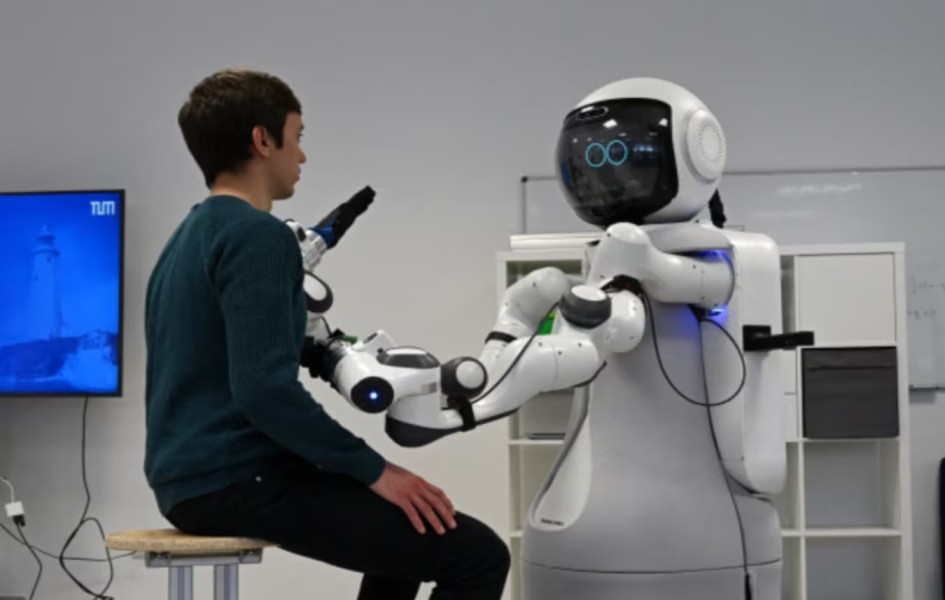Introduction:
The first use of robots in healthcare was in the 1980s to provide surgical assistance via robotic arm technologies. AI-enabled computer vision and data analytics have gradually altered medical robots, improving their capacities in healthcare.
In addition to the operation room, robots are used to help healthcare personnel in various activities and also promote patient care. Robotics in healthcare has the potential to revolutionize the way medical operations are carried out, enhance patient outcomes, and lessen the strain on healthcare systems. Robotics in healthcare has the potential to transform the way medical procedures are performed, improve patient outcomes, and reduce the burden on healthcare workers. In this blog, we will explore the types, impacts, challenges, and future role of robotics in healthcare.

The Major Types of Robots in Healthcare:
Sanitation using Robots
The COVID-19 pandemic highlighted the critical significance of sanitizing and cleaning care settings. Nowadays, in healthcare facilities, consistent and high-quality disinfection is important to the healing process.
Sanitation and disinfection are some of the major applications in which medical robots are used. These are simple and monotonous chores that require little talent. These maintenance workers can move on to other tasks which require much more human attention and leave these tasks to the robots
Nursing Robots
Even though nurses work exceptionally hard, there are just not enough of them to satisfy the demands of every single patient. Nursing robots assist understaffed teams.
Nurses must conduct several fundamental duties daily, such as taking blood and monitoring vital signs. These are critical activities, but the sheer number of these jobs is physically and emotionally taxing for nurses. Many of these everyday duties can now be performed by medical robots.
Social Robots
Social robots have direct interactions with humans. Social robots are used in long-term care environments for social interaction and monitoring. They encourage patients to follow treatment plans or provide cognitive stimulation to keep patients' alert. Robots are used for guiding patients and their families in hospitals. Thus, these social robots reduce the workloads of healthcare professionals and promote patients' well-being.
Microbots
These are microscopic robots moving throughout the human body while performing repairs. Microbots would perform surgery on patients without having to cut them open. Because these robots can be as small as a single human cell, they are far less likely than traditional surgical methods to cause tissue damage and other problems. Microbots may even be able to replace some pharmaceuticals, according to scientists.
It is extremely difficult to create robots this small with precise control. Researchers from all over the world are putting countless technological approaches to the test. As a result, it may take some time before microbots become an everyday medical tool.
Impacts:
Robotics has already made significant impacts in healthcare in several areas, including:
Surgery: Robotic surgery is becoming increasingly common, providing surgeons with greater precision, control, and visualization during procedures, leading to better patient outcomes.
Rehabilitation: Robots can help patients recover from injuries and illnesses by assisting with mobility, exercise, and therapy.
Diagnostics: Robots can analyze large amounts of patient data to identify patterns and anomalies that human observers might miss.
Challenges: -
Despite the potential benefits of robotics in healthcare, some challenges must be addressed, including:
Cost: Robotics technology can be expensive, making it difficult for healthcare organizations to justify the investment.
Safety: Robots must be designed and programmed to ensure patient safety and prevent errors or accidents.
Acceptance: Some healthcare providers and patients may be hesitant to embrace robotic technology, leading to slower adoption and implementation.
Future Role:
Looking ahead, the future role of robotics in healthcare includes,
As data analytics, machine learning, artificial intelligence, and other technologies advance, so will health robotics. Robots will continue to evolve and perform tasks autonomously, efficiently, and precisely.
Telemedicine: Robots are used in telemedicine to provide remote consultations and care, improving access to healthcare for patients in remote or underserved areas.
To know more, Visit: - https://mymedicalpanel.com/blogs/the-rise-of-telemedicine-has-impacted-modern-healthcare-but-what-are-its-limitations
Patient monitoring: Robots can assist in monitoring patients in real-time, collecting data, and alerting healthcare providers to potential issues.
Drug delivery: Robots can deliver medication to patients, ensuring accuracy and precision.
Elder care: As the population ages, robots can play an increasingly important role in assisting with activities of daily living and providing companionship.
Conclusion:
In conclusion, robotics has the potential to significantly impact the healthcare industry by improving surgical procedures, rehabilitation, and diagnostics. However, there are challenges such as cost, safety, and acceptance. Looking ahead, the future role of robotics in healthcare includes telemedicine, patient monitoring, drug delivery, and elder care. With ongoing advancements in technology and robotics, the use of robots in healthcare will increase in the coming years.
Opinion of MMPeer:
“Robots in the medical field are transforming how surgeries are performed, streamlining supply delivery and disinfection, and enabling providers to focus on engaging with and caring for patients. Benefits of Robotics in Healthcare
using robotics in the medical field enables a high level of patient care, efficient processes in clinical settings and a safe environment for patients and healthcare workers, these includes; Safe work environment, Surgical-Assistance Robots and Modular Robots etc.”- Dr. Daniel.
Are you a physician or healthcare practitioner?
Become a My Medical panel member and explore the many benefits of joining. Start your paid medical survey journey here - sign up










